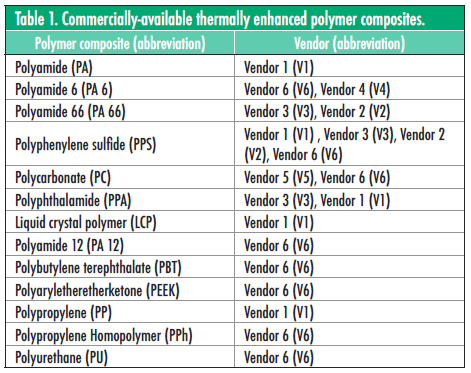Peter Rodgers, Editor
Valérie Eveloy, The Petroleum Institute
Introduction
The development, characterization, and implementation of polymer composite materials for the thermal management of electronic equipment has recently began to attract attention [1,2]. The enhanced thermal conductivity, low density, low cost, ease of manufacture and corrosion resistance of polymer composites make these materials attractive for the replacement of conventional heat sink and heat exchanger materials [3,4]. Polymer manufacturing is generally less expensive and energy-intensive than metal manufacturing [5]. Polymer low density also enables the manufacture of light structures that can facilitate assembly and transportation. Relative to standard polymers, composites have higher impact and yield strengths, higher temperature limits, and higher thermal conductivities [4]. The thermal and mechanical properties of the polymers are enhanced through the addition of fillers such as carbon fibers into the polymer matrix. The inclusion of up to 70% (volume %) carbon fibers, typically 100 to 300 µm long, 10 µm in diameter, having a thermal conductivity of up to 700 W/m.K, can increase polymer effective thermal conductivity from 0.5 to 30 W/m.K [6]. Thermally enhanced polymer composites can enable innovative designs that may not be manufactured with metals, owing to the moldability and thus geometric flexibility of polymer composites. Polymer composites are particularly suited to air cooling applications characterized by a low Biot number (i.e., high convective thermal resistance relative to the internal conductive resistance). However, their properties depend upon the injection molding process parameters and can be highly anisotropic. Thus, the fibers ideally require to be oriented in the primary direction of conduction heat transfer. Although thermal conductivity is of importance, many other material properties need to be carefully considered for the selection of a polymer composite for a given application.
In this Tech Brief, which is an abridged version of the analysis published in [2], the mechanical and thermal properties of approximately thirty commercially available, injection moldable, thermally enhanced polymer composites are reviewed to guide the selection of candidate materials that could replace conventional metals in heat exchangers applications for microelectronics cooling.
Thermal and Mechanical Properties
Current commercially-available, thermally enhanced polymer composite materials that can be injection molded, produced by six leading vendors, are compiled in Table 1. The majority of these materials use either polyamide 66 (PA 66) or Polyphenylene sulfide (PPS) as their matrix. For the purpose of non-commercialism, the vendors are anonymously designated throughout this article.
Before reviewing the properties of the materials listed in Table 1, the standards used for material characterization by the respective vendors were reviewed to ensure that the properties of polymer composites produced by different vendors can be compared on a like by like basis [2]. It was found that the standards used by the vendors are overall effectively equivalent.
A comparison of the thermal conductivity, tensile strength and modulus of the commercially-available polymer composites listed in Table 1, is presented in Figure 1. This comparison highlights that PA 66 group of materials have the highest thermal conductivity and tensile strength, and a high tensile modulus relative to other polymer composites.
A comparison of the flexural strength, flexural modulus and impact strength of the commercially-available polymer composites listed in Table 1, is presented in Figure 2. This data highlights that LCP has the highest flexural modulus (i.e., 32.3 MPa) and a good flexural strength. PA 66 materials have the highest flexural strength (179 – 193 MPa) and a good flexural modulus. Impact strength data for PA 66 from Vendor 3 is currently not available.
A comparison of the heat deflection temperature (HDT) and thermal conductivity of the commercially-available polymer composites at 1.8 MPa is presented in Figure 3. This data indicates that as thermal conductivity increases, the heat deflection temperature increases. PEEK has the highest HDT (i.e., 300 °C). Heat deflection temperature data is not available for PA 66 from Vendor 3.
Although not presented here in graphical format, a comparison of the density, elongation and mold shrinkage (both flow and cross-flow) of the commercially-available polymer composites listed in Table 1 was also undertaken. Mold shrinkage is an important parameter to determine the molding process conditions. It was found that PA 66 has the greatest elongation (i.e., up to 1.5%), but no mold shrinkage data was reported for this material. On the other hand, PEEK and PA12 have a high mold shrinkage (flow 0.65%, cross-flow 0.8%).
The mechanical property data of commercially-available polymer composite materials reported in vendor documentation product data is typically limited to single values, with property anisotropy not documented. As highlighted in [7], anisotropy in mechanical properties can however have a significant impact on the mechanical integrity of heat exchanger applications.
Table 2 summarizes the main results presented in Figures 1 to 3. As indicated in Table 2, PA66 appears to have the best combination of thermal conductivity and mechanical properties. On the other hand, LCP has the highest tensile strength and flexural modulus, while PEEK has the highest heat deflection point.
Table 3 compares the properties of the thermally enhanced composite polymers listed in Table 1 with those of the corresponding standard (i.e., non-thermally enhanced) polymer matrices.
To illustrate the variation in thermal and mechanical properties of a given polymer composite matrix between vendors, a comparison of the thermal conductivity, tensile strength, flexural strength, tensile modulus and flexural modulus of PPS between Vendors V1 to V6 is presented in [2]. This data reveals that the thermal and mechanical properties of a given polymer composite matrix can vary considerably between vendors. In particular, significant differences in properties are observed between Vendors 1 and 3, who offer PPS materials having the same thermal conductivity. For example, product 11, V3 and product 10, V1, which both have a reported thermal conductivity of 20 W/m.K, exhibit 27%, 19% and 36 % difference in tensile strength, flexural strength and tensile modulus, respectively. This is possibly related to the type and quantity of filler used in each material.
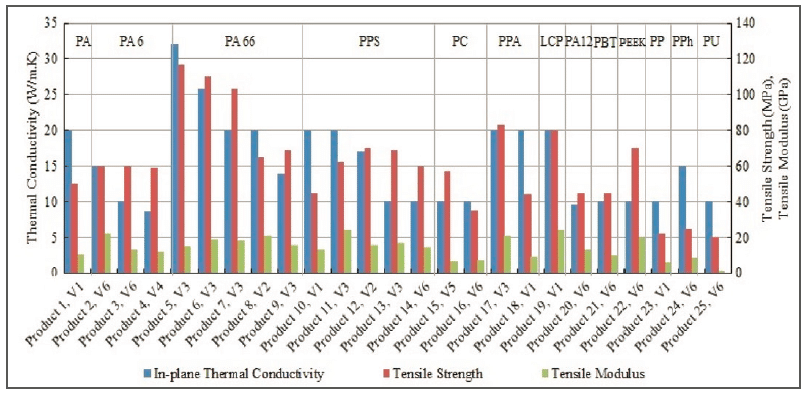
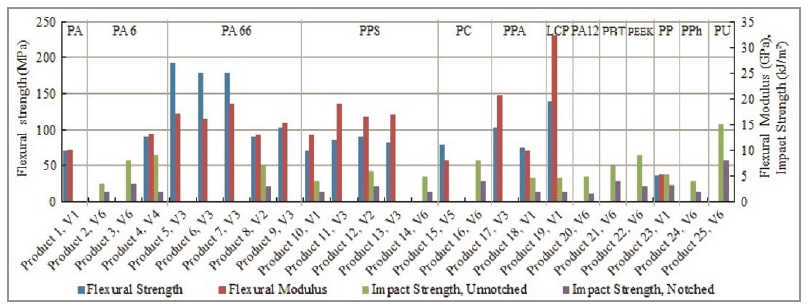
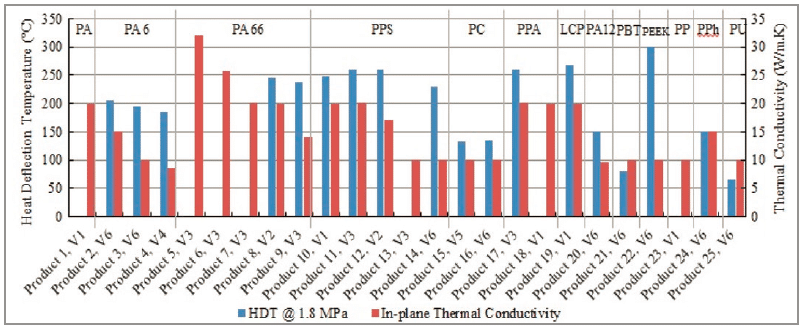
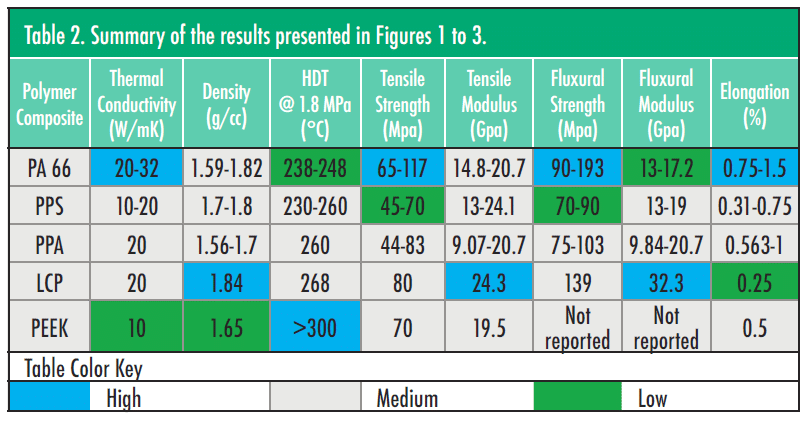
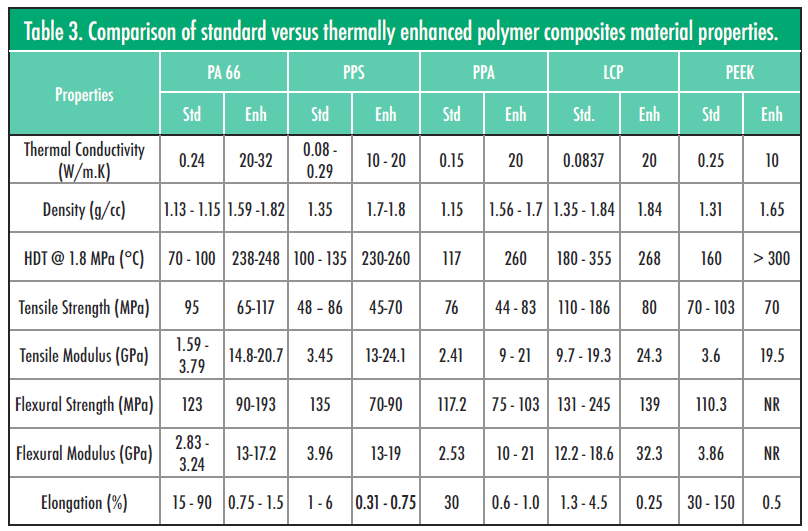
Summary
Based on the data presented for commercially-available thermally enhanced polymer composite materials, polyamide 66 (PA 66) was found to have the best overall combination of thermal and mechanical properties at room temperature. Polyphenylene sulfide (PPS) also has a good combination of thermal and mechanical properties, and low processing conditions (e.g., temperature, pressure), but slightly lower mechanical properties. The material characterization data reviewed requires to be extended to conditions specific to electronic cooling applications, as well as to mechanical integrity, lifetime durability and material processability tests. The magnitude of polymer composite material mechanical property anisotropy for the materials considered in this study should also be investigated, as well as the impact of anisotropy on heat exchanger structural integrity.

is an Associate Professor of Mechanical Engineering at The Petroleum Institute, UAE. Previously, she was an Assistant Research Scientist at the University of Maryland, MD, USA, and Research Engineer at Nokia, Finland. Her present research interests include sustainable energy technologies, computational fluid dynamics, environmental emission dispersion, and polymeric heat exchangers. She has authored/co-authored over 90 refereed journal/conference publications, one book chapter, and co-edited the First and Second International Energy 2030 Conference proceedings. Dr. Eveloy is a member of international conference program committees focused on energy technologies, thermal phenomena in electronic systems; the EU-GCC Clean Energy Network II (2016–2018) and ASME.
Acknowledgements
The financial support of ADNOC Research & Development Gas Sub-Committee is gratefully acknowledged.
References
[1] Deisenroth, D.C. Arie, M.A., Dessiatoun, S., Shooshtari, A. Ohadi, M., and Bar-Cohen, A., 2015, “Review of Most Recent Progress on Development of Polymer Heat Exchangers for Thermal Management Applications,” ASME 2015 International Technical Conference and Exhibition on Packaging and Integration of Electronic and Photonic Microsystems, San Francisco, California, USA, July 6–9, Paper No. IPACK2015-48637, 10 pages.
[2] Eveloy, V., Rodgers, P., and Diana, A., “Performance Investigation of Thermally Enhanced Polymer Composite Materials for Microelectronics Cooling,” Microelectronics Journal, Vol. 46, pp. 1216-1224 (2015).
[3] Bahadur, R., and Bar-Cohen, A., “Orthotropic thermal conductivity effect on cylindrical pin fin heat transfer,” International Journal of Heat and Mass Transfer, Vol. 50, pp. 1155–1162, 2007.
[4] Cevallos, J.G., Bergles, A.E., Bar-Cohen, A., Rodgers, P., and Gupta, S.K., “Polymer Heat Exchangers – History, Opportunities, and Challenges,” Heat Transfer Engineering, 33(13) pp. 1075-1093, 2012.
[5] Luckow, P., Bar-Cohen, A., Rodgers P., and Cevallos, J., “Energy Efficient Polymers for Gas-Liquid Heat Exchangers,” Journal of Energy Resources Technology, Vol. 132, pp. 021001-1/9, 2010.
[6] Bahadur, R., “Characterization, Modeling and Optimization of Polymer Composite Pin Fins,” Doctor of Philosophy Thesis, University of Maryland, College Park, MD, USA, 2005.
[7] Robinson, F., Cevallos, J.G., Bar-Cohen A., and Bruck, H., “Modeling and Validation of a Prototype Thermally-Enhanced Polymer Heat Exchanger,” Proceedings of the ASME 2011 International Mechanical Engineering Congress & Exposition (IMECE2011), November 11-17, 2011, Denver, Colorado, USA, Paper No. IMECE2011-65684.

